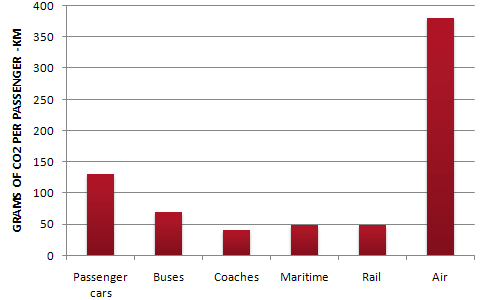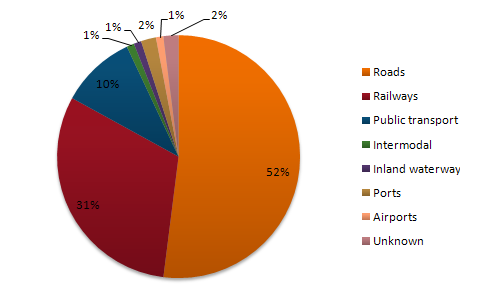» You should spend about 20 minutes on this task.
The graph below shows CO2 emissions for different forms of transport in the European Union. The Pie Chart shows the percentage of European Union funds being spent on different forms of transport.
Write a report for a university lecturer describing the information in the graph below.
» You should write at least 150 words.


Sample Answer 1:
The bar chart summaries how much C02 is discharged for one-kilometre travel by a passenger in different transportations and the pie chart shows the ratio of European Union’s expenditure for a variety of transport systems. Generally speaking, air travel emits the highest amount of Carbon Dioxide and EU spend the most on the road carriers.
As can be seen, one-kilometre air travel for a passenger is responsible for roughly 375 grams of CO2 emission which is significantly higher than that of other modes of travel. A car passenger contributes to approximately 130 grams CO2 while this is nearly 70 grams for a bus commuter. Coaches, rails and maritime produces almost 50 grams of CO2 for one-kilometre passenger travel.
According to the pie chart, more than half of the EU budget is spent on road transport system which is the highest. Nearly one-third of the budget is allocated for the rail transports while one-tenth goes on public transports. Despite emitting the highest CO2 per traveller, air transports receive only 1% of the EU’s budget. All other transport systems receive 1-2% of the EU budget each which is relatively much lower the spending on roads and railways.
Sample Answer 2:
The graphs outline the amount of Carbon dioxide emission per passenger from different vehicles in the European Union and the EU expenditures on different modes of transportation. Overall, the highest amount of CO2 per person is emitted by the Air transports and the European Union spends the highest percentage of funds for the road transportation system.
According to the bar graph, a single passenger of a personal car is responsible for around 130 gm of CO2 per kilometre while a passenger in a bus contributes to 65 gm CO2 eruption per kilometre. Coaches, maritime and rail passengers emit the lowest amount of CO2 which is about 50 grams per passenger. Finally, an aeroplane traveller contributes to 370 km of CO2 per kilometre which is the highest.
Based on the pie chart, the European Union spent the highest amount (52%) on the road transportation system while spent only 1% to 2% on ports, waterway airport intermodal and other transport systems. They spent 31% on the rail system and 10% on the public transportation system. This indicates the European Union spent the majority of the budget on public transportations.
( This model answer can be followed as an example of a very good answer. However, please note that this is just one example out of many possible approaches.)
Sample Answer 3:
The bar graph presents comparative data on the amount of CO2 eruption per passenger kilometre travel in different modes of vehicles while the pie chart shows the ratio of the European Union’s spending on these forms of transportation. As is clear from the given illustration, Carbon dioxide discharge per passenger in the air travel is significantly higher than any other mode of transportation and more than half of the European Union’s spending goes on the road transport system.
According to the given bar graph, more than 350 grams of CO2 ejection happens when a passenger travels one km in an aeroplane. This Carbon dioxide emission is quite higher than any other form of transportation. The second highest CO2 release is caused by private cars which are responsible for discharging about 130 gm of CO2 per passenger km. Buses, maritime and rails are responsible for the release of around 50 grams of CO2 per passenger. Finally, coaches are the most eco-friendly transportations as they emit less than 50 grams of Carbon dioxide per passenger kilometre.
On the other hand, the pie chart depicts the fund being spent on different modes of transportation types and it is obvious that more than half of their spending goes on roads. Railways get the second highest funding which is 31%. Public transportation funding amounts 10% while all other transportations’ EU budget amounts less than 10% costs.
Sample Answer 4:
The column graph shows the amount of CO2 release from different means of transports in the European Union and the pie chart outlines how the European Union distributes its budget on different transportation types. In general, air transports emit the highest volume of C02, and vehicles on roads and railways together consume most of the European Union’s expenditure budget on transports.
To begin with, nearly 400 grams of CO2 ejection happens when a passenger travels a kilometre in an aeroplane. Following that, personal cars stand at the second position with a remarkably lower figure of CO2 emision – approximately 130 grams per passenger kilometre. Buses are responsible for 70 grams of emission while this figure is 40 grams for coaches, which is the lowest. Finally, the Maritimes and rails are reported to have the same volume of CO2 discharge, 50 grams for a kilometre travel by a passenger.
As can be seen from the pie chart, more than half of the transport related expenditure by the EU goes to road transports. Nearly one-third of their total budget is spent on railways and a tenth is used for bus communications. The remaining 7% budget is then spent on other transportation types.
[Writtne by – Thuy Linh]
